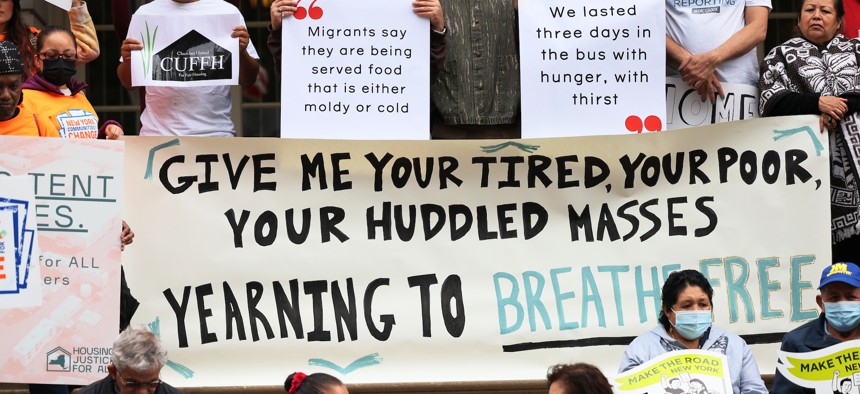Opinion
Opinion: Permanent housing for asylum seekers isn’t just fiscally responsible – it’s our moral obligation
New York City could save a whopping $3 billion dollars a year by opening up eligibility to housing vouchers for asylum-seekers.

Community members, housing rights activists and elected officials gather for a rally and press conference outside City Hall on Oct. 13, 2013, to call on Mayor Eric Adams to provide safer alternative solutions and more stable housing for asylum seekers and their families. Michael M. Santiago/Getty Images
The holiday season is just around the corner, and soon New Yorkers will be gathering with loved ones, cozying up inside and forming cherished memories. But this year, thousands of families seeking asylum will spend the holiday season in city-run shelters, lacking the stability and safety of permanent housing.
And the city is now destabilizing these families even further, imposing a 60-day limit on shelter stays for new arrivals. This move requires families to travel across the city to reapply for shelter at intake centers and find placement wherever a bed is available. How are newcomers supposed to get two feet on the ground and support themselves when they’re forced to uproot their lives, their children’s education and their belongings every 60 days?
The arbitrary 60-day rule is the latest inefficiency in the city’s strategy to welcome asylum seekers. It has been entirely focused on creating emergency shelters by re-adapting hotels and government offices and installing tents in parking lots and cots in airplane hangars. This is a lose-lose strategy. Not only is it too costly to implement, but it fails to meet the basic needs of arriving families.
More than a year since the first buses from Texas arrived, it’s well past time for the city to move away from an emergency response and implement a long-term strategy that gets people onto their feet and into permanent housing. This is not a “migrant crisis,” but the latest episode of a long-existing housing and affordability crisis.
Of the more than 100,000 asylum-seekers who arrived in New York City in the past year, tens of thousands have left the shelter system. Even so, nearly 65,000 newcomers remain in the city’s care as they seek asylum, a legal and human right guaranteed under both U.S. and international law.
Rather than working to find solutions, all levels of government have been stuck in a blame-game, pointing fingers at each other and skirting responsibility for meeting this moment. While the city has limited control over the state and federal government’s response to these calls for help, we are not helpless. The City of New York does control the material conditions of asylum seekers in their care.
Amid all the politicking, we’re losing sight of the humanity of new arrivals who come to America fleeing violence, political instability, sexual abuse and more. And these new arrivals have been met by an increase in ugly, sometimes violent protests, from Staten Island to Gracie Mansion. This behavior has been reinforced by Mayor Eric Adams’ senseless comments that asylum seekers will “destroy” New York City. We are falling short of our legacy as a city of immigrants, and our leaders are failing to unify New Yorkers against reductive, xenophobic rhetoric. The only thing anyone seems to agree on is that New York needs smart solutions now. Luckily, we have one.
Win and the New York Immigration Coalition have recently found that New York City could save a whopping $3 billion dollars a year by opening up eligibility to housing vouchers for asylum-seekers. Housing subsidy programs like CityFHEPS are widely recognized as one of the most effective tools to combat homelessness, and now they stand to greatly reduce shelter costs. Ultimately, streamlining access to vouchers and permanent housing is a solution that makes fiscal, logistical and moral sense.
Unfortunately, immigrant families and children are currently ineligible for these housing solutions – an exclusion that will only result in a greater fiscal cost for New Yorkers. CityFHEPS vouchers cost just $72 per night for families living in a 2-bedroom apartment. In contrast, New York City is currently spending on average $394 to shelter households in emergency hotels. At current population demands, the cost of sheltering asylum seekers in emergency hotels pencils out to $3.58 billion dollars per year, compared to just $673 million with CityFHEPS vouchers, a cost savings of $2.9 billion per year.
An added benefit to vouchers? Once families are placed in subsidized housing, they are far less likely to re-enter the shelter system. In Fiscal Year 2022, 15% of families who exited shelter without a subsidy returned within one year, compared to less than 1% of families who exited with a subsidy.
In fairness to the Adams administration, our city’s shelter crisis existed long before asylum-seekers began arriving last year. Tens of thousands of homeless New Yorkers already struggled to access affordable, permanent housing. We can no longer rely on band-aid remedies to fix our shelter system.
Adams and the City Council can’t force Congress to expedite work permits and Gov. Hochul remains unwilling to compel upstate counties to welcome all new arrivals. But New York City can and should expand vouchers to all households in need, regardless of their immigration status.
Doing so would save billions of dollars while helping the newest New Yorkers exit shelters, allowing them to create a better future for themselves and enrich New York’s cultural and economic fabric.
Murad Awawdeh is the executive director of the New York Immigration Coalition. Christine Quinn is the CEO of Win, the largest services provider for homeless families in New York City. She previously served as New York City Council Speaker.
NEXT STORY: Opinion: New York needs better regulation of commercial surrogacy and sperm and egg donations

